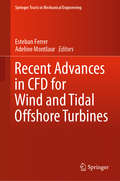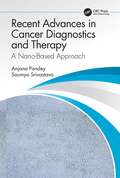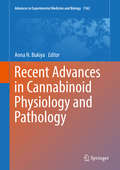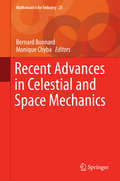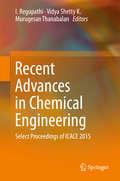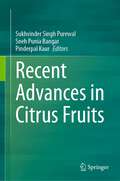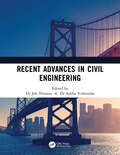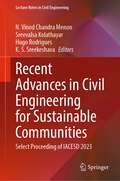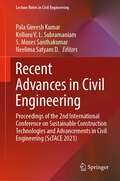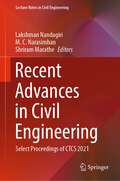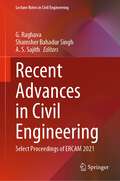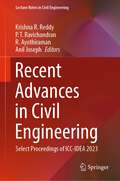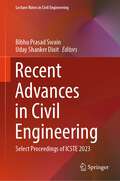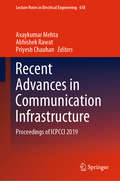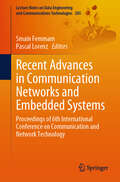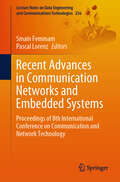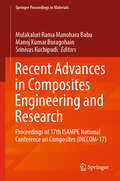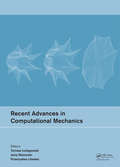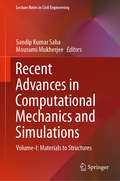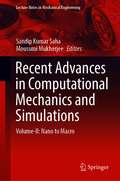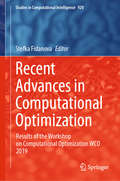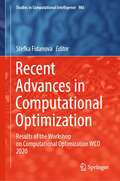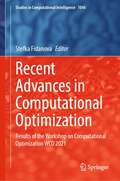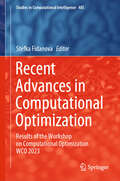- Table View
- List View
Recent Advances in CFD for Wind and Tidal Offshore Turbines (Springer Tracts in Mechanical Engineering)
by Esteban Ferrer Adeline MontlaurThe book presents novel Computational Fluid Dynamics (CFD) techniques to compute offshore wind and tidal applications. The papers in this volume are based on a mini-symposium held at ECCOMAS 2018. Computational fluid dynamics (CFD) techniques are regarded as the main design tool to explore the new engineering challenges presented by offshore wind and tidal turbines for energy generation.The difficulty and costs of undertaking experimental tests in offshore environments have increased the interest in CFD which is used to design appropriate turbines and blades, understand fluid flow physical phenomena associated with offshore environments, predict power production or characterise offshore environments amongst other topics.
Recent Advances in Cancer Diagnostics and Therapy: A Nanobased Approach
by Anjana Pandey Saumya SrivastavaThe book provides information about different types and stages of cancers and their subtypes with their respective molecular mechanisms, etiology, histopathology and cellular origins of cancer. The book also provides detailed information about cancer incidence, mortality, different type of technologies both bio and nano employed in cancer diagnosis and screening and their applications in cancer therapies. The book will serve the purpose to impart knowledge to its readers about molecular mechanisms of cancer, diagnosis and therapies along with different computational techniques used on a single platform. The chapters include a broad and integrated perspective on cancer related topics. The book covers both conventional and emerging techniques employed in cancer screening and diagnosis including imaging, biomarker and electrochemical nanosensor based approaches with detailed information on sensor development. Similarly, the book also covers the mechanisms of different conventional and emerging herbal & nano therapies used in cancer treatment. The authors then discuss about applications of different computational and mathematical tools such as machine learning methods that can be employed in cancer diagnosis and therapy at the level of personalized medicine. The target readers for the book include university students, course lectures, researchers and industrialists working in the fields of cancer biology, medicine, and pharmacology. Features: An integrated approach to provide information about all aspects of cancer biology, diagnosis and therapy. Covers both conventional and emerging tools/ techniques applicable in cancer screening and diagnosis. Covers the mechanisms of conventional and emerging anticancer drugs and therapies. Provides insights about personalized medicine based approach in cancer diagnosis and therapy.
Recent Advances in Cannabinoid Physiology and Pathology (Advances in Experimental Medicine and Biology #1162)
by Anna N. BukiyaThe cannabinoid system plays a central role in a wide variety of physiological functions that touch upon cardiovascular, gastrointestinal, immune, and nervous systems. Cannabinoids also play a central role in developmental physiology, management of pain, and shaping of human behaviour. Recent movements towards legalization of marijuana use have bolstered scientific interest in the cannabinoid field and led to research efforts that would unveil multi-faceted effects and mechanisms of cannabinoid presence in different organs and at various stages of development. This book summarizes the recent advances in the field of cannabinoid research at multiple levels of resolution. It spans from systemic effects of cannabinoids on development, physiological function, and prevalent pathophysiological conditions to mechanisms that govern cannabinoid interaction with their relevant protein targets at atomic resolution. This book will be of interest to a specialized audience in the fields of biochemistry, pharmacology and developmental biology but alsoto a wider readership with interest in general physiology and cannabinoid signalling in biological systems.
Recent Advances in Celestial and Space Mechanics
by Bernard Bonnard Monique ChybaThis book presents recent advances in space andcelestial mechanics, with a focus on the N-bodyproblem and astrodynamics, and explores the development and application of computational techniques in bothareas. It highlights the design of space transfers with various modes ofpropulsion, like solar sailing and low-thrust transfers between libration pointorbits, as well as a broad range of targets and applications, like rendezvouswith near Earth objects. Additionally, it includes contributions on thenon-integrability properties of the collinear three- and four-body problem, andon general conditions for the existence of stable, minimum energyconfigurations in the full N-body problem. A valuable resource for physicists and mathematicians with research interests in celestialmechanics, astrodynamics and optimal control as applied to spacetransfers, as well as for professionals and companies in the industry.
Recent Advances in Chemical Engineering
by I Regupathi Vidya Shetty K Murugesan ThanabalanThe book introduces the outcomes of latest research in the field of Chemical Engineering. The book also illustrates the application of Chemical Engineering principles to provide innovative and state of the art solutions to problems associated with chemical industries. It covers a wide spectrum of topics in the area of Chemical Engineering such as Transfer operations, novel separation processes, adsorption, photooxidation, process control, modelling, and simulation. The book provides timely contribution towards implementation of recent approaches and methods in Chemical Engineering Research. It presents chapters focussed on several Chemical Engineering principles and methodologies of wide multidisciplinary applicability. The intended audience of this book will mainly consist of researchers, research students, and practitioners in Chemical Engineering and allied fields. The book can also serve researchers and students involved in multidisciplinary research.
Recent Advances in Citrus Fruits
by Sneh Punia Bangar Sukhvinder Singh Purewal Pinderpal KaurWhen compared to other major fruits, citrus fruits have resistance to pests and diseases, a short growing season and productivity even under harsh environmental conditions. Worldwide, citrus fruits are well known for their nutrients-rich juice and medicinal properties. Juice extracted from citrus fruits is rich source of vitamin C and various antioxidant compounds that are required to sustain a healthy life. Fruits are consumed in raw as well as processed forms, and the pharmacological importance of citrus fruits are not only limited to its edible parts, but also to non edible seeds and peel that are also a rich source of bioactive constituents with health benefiting properties. In current fruit processing techniques the peel is discarded as a byproduct after extraction of the juice. Researchers and food scientists are now focusing on utilization of fruit waste/byproducts to use them as a substrate in food processing, cosmetic and pharmaceutical industries. Whole fruits, seeds contain important antioxidant and antimicrobial properties. Recent advances in Citrus Fruits provide in-depth knowledge on the nutritional profile, production details, processing, products and health benefits of citrus fruits. The most important citrus fruits, from lemons and limes to grapefruit and mosambi are covered in full, providing researchers with full breakdowns on each citrus fruit's nutritional makeup, processing specifics and agrarian importance, health benefits and use in various products across a wide range of industries. This text covers all of the latest research related to citrus fruits and provides researchers with a curated source on these valuable fruits.
Recent Advances in Civil Engineering
by Job Thomas Subha VishnudasThe Civil Engineering department of Cochin University of Science and Technology organized an International Conference on Recent Advances in Civil Engineering (ICRACE) to disseminate the know-how and challenges in this area among technocrats, practicing civil engineers, researchers etc. This conference has been conducted biennially since 2004. The conference holds an interactive platform to find solution for various problems in construction field.
Recent Advances in Civil Engineering for Sustainable Communities: Select Proceeding of IACESD 2023 (Lecture Notes in Civil Engineering #459)
by Hugo Rodrigues Sreevalsa Kolathayar N. Vinod Chandra Menon K. S. SreekeshavaThis book presents select proceedings of the International Conference on Interdisciplinary Approaches in Civil Engineering for Sustainable Development (IACESD 2023). The topics covered include geographic information systems (GIS) and building information modeling (BIM), integration of numerical methods for fluid flow modeling, and the revolutionary potential of 3D printing within the construction industry. This book serves as a resource material for researchers and industry professionals interested in developing solutions for sustainable and resilient infrastructure that aims for communities with Net Zero Targets.
Recent Advances in Civil Engineering: Proceedings of the 2nd International Conference on Sustainable Construction Technologies and Advancements in Civil Engineering (ScTACE 2021) (Lecture Notes in Civil Engineering #233)
by Pala Gireesh Kumar Kolluru V. L. Subramaniam Moses Santhakumar M. Neelima Satyam D.The book presents the select proceedings of the 2nd International Conference on Sustainable Construction Technologies and Advancements in Civil Engineering (ScTACE 2021). This book discusses the latest developments and contributions towards sustainable construction technologies and advances in civil engineering. Various topics covered in this book are construction technologies, geotechnical engineering, transportation and traffic engineering, structural engineering, environmental engineering, remote sensing and GIS, geo-environmental engineering, water resources engineering and earthquake engineering. This book will be useful for students, researchers and professionals working in the area of civil engineering.
Recent Advances in Civil Engineering: Select Proceedings of CTCS 2021 (Lecture Notes in Civil Engineering #256)
by M. C. Narasimhan Shriram Marathe Lakshman NandagiriThis book presents the select proceedings of the International Conference on Civil Engineering Trends and Challenges for Sustainability (CTCS 2021). It discusses emerging and latest research and advances in sustainability in different areas of civil engineering, providing solutions to sustainable development. Various topics covered include sustainable construction technology & building materials; structural engineering, transportation and traffic engineering, geotechnical engineering, environmental engineering, water resources engineering, remote sensing and GIS applications. This book will be of potential interest to researchers and professionals working in sustainable civil engineering and related fields.
Recent Advances in Civil Engineering: Select Proceedings of ERCAM 2021 (Lecture Notes in Civil Engineering #265)
by A. S. Sajith Shamsher Bahadur Singh G. RaghavaThe book presents the select proceedings of the Third International Conference on Emerging Research in Civil, Aeronautical and Mechanical Engineering 2021 (ERCAM 2021). The book highlights the latest advances in structural engineering, geotechnical engineering, construction management, water resources engineering, transportation engineering, environmental engineering, remote sensing, etc., It also covers the emerging areas such as sustainability, green building technologies, zero-energy buildings, smart materials, smart cities, and intelligent transportation systems. The book will be useful for students, researchers and industry professionals working in the field of civil engineering.
Recent Advances in Civil Engineering: Select Proceedings of ICC-IDEA 2023 (Lecture Notes in Civil Engineering #398)
by Krishna R. Reddy Anil Joseph R. Ayothiraman P. T. RavichandranThis book presents the select proceedings of International Conference on Civil Engineering: Innovative Development in Engineering Advances (ICC-IDEA 2023). This book covers the latest research in the areas of geotechnical engineering, geomatics, geosciences, remote sensing, geographical information systems, surveying and geo-spatial engineering, environmental engineering, and many more. The book is useful for researchers and professionals in civil engineering.
Recent Advances in Civil Engineering: Select Proceedings of ICSTE 2023 (Lecture Notes in Civil Engineering #431)
by Uday Shanker Dixit Bibhu Prasad SwainThis book presents select proceedings of the International Conference on Science, Technology and Engineering (ICSTE 2023) related to recent advances in Civil Engineering. The book provides a comprehensive collection of cutting-edge research that covers the areas of building construction and design, construction materials, construction management, remote sensing, geographical information systems, environmental engineering, etc. The book is useful for researchers and professionals in civil engineering.
Recent Advances in Communication Infrastructure: Proceedings of ICPCCI 2019 (Lecture Notes in Electrical Engineering #618)
by Axaykumar Mehta Abhishek Rawat Priyesh ChauhanThis book gathers selected research papers presented at the International Conference on Power, Control and Communication Infrastructure 2019 (ICPCCI 2019), organized by the Institute of Infrastructure, Technology, Research and Management (IITRAM), Ahmedabad, Gujarat, India, on July 4–5, 2019. It presents technological developments in the fields of communications infrastructure which comprise of architecture, products, and network connections that allow for communications over the long distances. The book includes some innovative ideas in the field of communication infrastructure, specially satellite communication, navigation systems, artificial neural network, encryption techniques, and some other infrastructure-related developments. The solution approaches provided in this book encourage and inspire researchers, industry professionals, and policymakers to put these methods into practice.
Recent Advances in Communication Networks and Embedded Systems: Proceedings of 6th International Conference on Communication and Network Technology (Lecture Notes on Data Engineering and Communications Technologies #205)
by Pascal Lorenz Smain FemmamThis book is devoted to enhanced version of selected papers presented at the 7th International Conference on Communication and Network Technology (ICCNT 2023). The objective of the proceedings of ICCNT 2023 is to present the recent research results and technological advances in the fields of theoretical and experimental applications of embedded systems, communications and signal processing decision as well as in emerging areas related to the tracks of the conference. The specific topics of interest within the scope of this special issue include design tools for electronics and embedded systems: embedded systems and software, system-on-chip (SoC), multiprocessor system-on-chip (MPSoC) platforms and applications, network-on-chip (NoC) design methodologies, reconfigurable computing, system design, synthesis, and optimization, advanced communications: circuits and systems for communications, optical fibers applications: optical communications, sensors, image, laser applications in: telemetry, LiDAR system, anemometry, computer 3D visions, range technique, RF and wireless communications, image and signal processing decision: image and video processing technology, compression, coding and implementation, cryptology and watermarking, real-time systems, sensors and instrumentation: data acquisition, audio, acoustic speech, biomedical signal processing, sensor microsystems and industrial sensors, computer engineering and networks: cloud computing technology, internet technology, computer security, computing networks, and data acquisition.
Recent Advances in Communication Networks and Embedded Systems: Proceedings of 8th International Conference on Communication and Network Technology (Lecture Notes on Data Engineering and Communications Technologies #256)
by Pascal Lorenz Smain FemmamThis book presents an enhanced selection of papers from the 7th International Conference on Communication and Network Technology (ICCNT 2023). It highlights recent research and technological advances in embedded systems, communications, and signal processing, along with emerging topics in these fields. Key areas covered include: Embedded Systems & Electronics: SoC, MPSoC, NoC, reconfigurable computing, system design, and optimization. Advanced Communications: Circuits, optical fiber applications, RF and wireless communications. Image & Signal Processing: Video processing, compression, cryptology, watermarking, real-time systems. Sensors & Instrumentation: Data acquisition, biomedical signal processing, industrial sensors. Computer Engineering & Networks: Cloud computing, cybersecurity, internet technology, and computing networks. The book serves as a resource for researchers and professionals in these cutting-edge technological domains.
Recent Advances in Composites Engineering and Research: Proceedings of 17th ISAMPE National Conference on Composites (INCCOM-17) (Springer Proceedings in Materials #39)
by Manoj Kumar Buragohain Mulakaluri Rama Manohara Babu Srinivas KuchipudiThis volume presents select proceedings of ISAMPE National Conference on Composites (INCCOM-17). The volume focuses on recent developments in the composite industry for manufacturing including aerospace, defense, civilian and automobile industries. The content include chapters on research topics such as design, analysis and simulation, processing and composite tooling, high temperature composites, carbon-carbon composites, ultra high temperature composites, nano and smart composites, structural health monitoring, material characterization, non-destructive evaluation of composite structures, damage tolerance in composites, composite process modelling and simulation, composite repair technology, AI in composites, additive manufacturing of composites, start-up ideas in composite technology and applications of composites. This volume will be of interest to researchers and professionals in the fields of materials and mechanical engineering.
Recent Advances in Computational Mechanics
by Jerzy Rakowski Tomasz Łodygowski Przemysław LitewkaRecent Advances in Computational Mechanics contains selected papers presented at the jubilee 20th Conference on Computer Methods in Mechanics (CMM 2013), which took place from 27 to 31 August 2013 at the Poznan University of Technology. The first Polish Conference on Computer Methods in Mechanics was held in Poznan in 1973. This very successful me
Recent Advances in Computational Mechanics and Simulations: Volume-I: Materials to Structures (Lecture Notes in Civil Engineering #103)
by Sandip Kumar Saha Mousumi MukherjeeThis book presents selected papers from the 7th International Congress on Computational Mechanics and Simulation, held at IIT Mandi, India. The papers discuss the development of mathematical models representing physical phenomena and apply modern computing methods to analyze a broad range of applications including civil, offshore, aerospace, automotive, naval and nuclear structures. Special emphasis is given on simulation of structural response under extreme loading such as earthquake, blast etc. The book is of interest to researchers and academics from civil engineering, mechanical engineering, aerospace engineering, materials engineering/science, physics, mathematics and other disciplines.
Recent Advances in Computational Mechanics and Simulations: Volume-II: Nano to Macro (Lecture Notes in Mechanical Engineering #103)
by Sandip Kumar Saha Mousumi MukherjeeThis volume presents selected papers from the 7th International Congress on Computational Mechanics and Simulation held at IIT Mandi, India. The papers discuss the development of mathematical models representing physical phenomena and applying modern computing methods and simulations to analyse them. The studies cover recent advances in the fields of nano mechanics and biomechanics, simulations of multiscale and multiphysics problems, developments in solid mechanics and finite element method, advancements in computational fluid dynamics and transport phenomena, and applications of computational mechanics and techniques in emerging areas. The volume will be of interest to researchers and academics from civil engineering, mechanical engineering, aerospace engineering, materials engineering/science, physics, mathematics and other disciplines.
Recent Advances in Computational Optimization: Results of the Workshop on Computational Optimization WCO 2019 (Studies in Computational Intelligence #920)
by Stefka FidanovaThis book is a comprehensive collection of extended contributions from the Workshops on Computational Optimization 2019.Our everyday life is unthinkable without optimization. We try to minimize our effort and to maximize the achieved profit.Many real-world and industrial problems arising in engineering, economics, medicine and other domains can be formulated as optimization tasks.This book presents recent advances in computational optimization. The book includes important real problems like modeling of physical processes, wildfire and flood risk modeling, workforce planning, parameter settings for controlling different processes, optimal electrical vehicle modeling, bioreactor modeling and design of VLSI.It shows how to develop algorithms for them based on new intelligent methods like evolutionary computations, ant colony optimization, constrain programming and others. This research demonstrates how some real-world problems arising in engineering, economics and other domains can be formulated as optimization problems.
Recent Advances in Computational Optimization: Results of the Workshop on Computational Optimization WCO 2020 (Studies in Computational Intelligence #986)
by Stefka FidanovaThis book presents recent advances in computational optimization. Our everyday life is unthinkable without optimization. We try to minimize our effort and to maximize the achieved profit. Many real-world and industrial problems arising in engineering, economics, medicine and other domains can be formulated as optimization tasks. The book is a comprehensive collection of extended contributions from the Workshops on Computational Optimization 2020. The book includes important real problems like modeling of physical processes, workforce planning, parameter settings for controlling different processes, transportation problems, wireless sensor networks, machine scheduling, air pollution modeling, solving multiple integrals and systems of differential equations which describe real processes, solving engineering problems. It shows how to develop algorithms for them based on new intelligent methods like evolutionary computations, ant colony optimization, constrain programming and others. This research demonstrates how some real-world problems arising in engineering, economics and other domains can be formulated as optimization problems.
Recent Advances in Computational Optimization: Results of the Workshop on Computational Optimization WCO 2021 (Studies in Computational Intelligence #1044)
by Stefka FidanovaThis book presents recent advances in computational optimization. The book includes important real problems like modeling of physical processes, parameter settings for controlling different processes, transportation problems, machine scheduling, air pollution modeling, solving multiple integrals and systems of differential and integral equations which describe real processes, solving engineering and financial problems.It shows how to develop algorithms for them based on new intelligent methods like evolutionary computations, ant colony optimization, constrain programming Monte Carlo method and others. This research demonstrates how some real-world problems arising in engineering, economics and other domains can be formulated as optimization problems.
Recent Advances in Computational Optimization: Results of the Workshop on Computational Optimization WCO 2023 (Studies in Computational Intelligence #485)
by Stefka FidanovaThis book presents recent advances in computational optimization. The book includes important real problems like modelling of physical processes, workforce planning problem, transportation problems, machine scheduling, air pollution modelling, optimization of fast-food restaurant chain, solving engineering, and financial problems. Our everyday life is unthinkable without optimization. We try to minimize our effort and maximize the achieved profit. Many real-world and industrial problems arising in engineering, economics, medicine, and other domains can be formulated as optimization tasks. The book is a comprehensive collection of extended contributions from the Workshops on Computational Optimization 2023. It shows how to develop algorithms for them based on new intelligent methods like evolutionary computations, ant colony optimization, constrain programming Monte Carlo method, and others. This research demonstrates how some real-world problems arising in engineering, economics, and other domains can be formulated as optimization problems.
Recent Advances in Computational Optimization: Selected Papers from the WCO 2022 – Workshop on Computational Optimization (Studies in Computational Intelligence #1158)
by Stefka FidanovaThe book is a comprehensive collection of extended contributions from the Workshops on Computational Optimization 2022. Our everyday life is unthinkable without optimization. We try to minimize our effort and to maximize the achieved profit. Many real world and industrial problems arising in engineering, economics, medicine, and other domains can be formulated as optimization tasks. This book presents recent advances in computational optimization. The book includes important real problems like modeling of physical processes, parameter settings for controlling different processes, agricultural modeling transportation problems, energy management, machine scheduling, air pollution modeling, optimization of fast-food restaurant chain, and solving engineering and financial problems. It shows how to develop algorithms for them based on new intelligent methods like evolutionary computations, ant colony optimization, constrain programming Monte Carlo method, and others. This book demonstrates how some real-world problems arising in engineering, economics, and other domains can be formulated as optimization problems.
